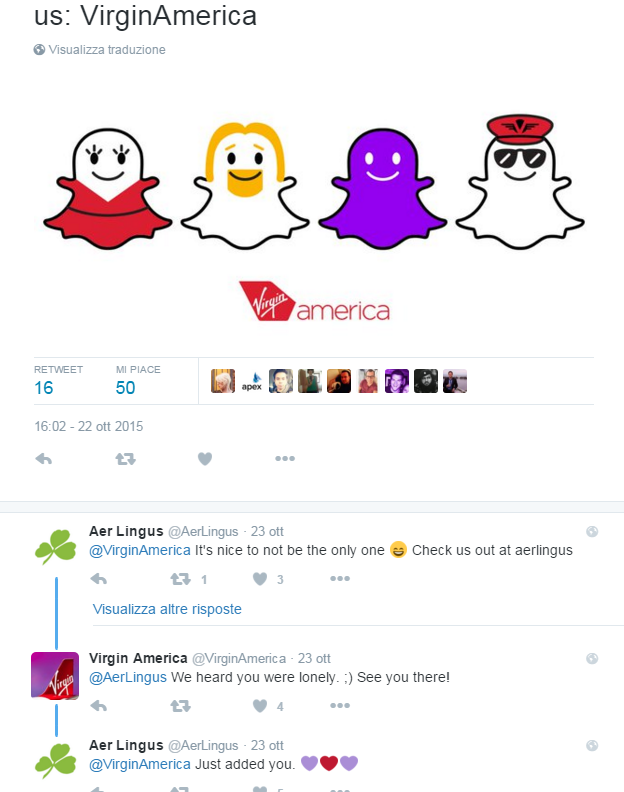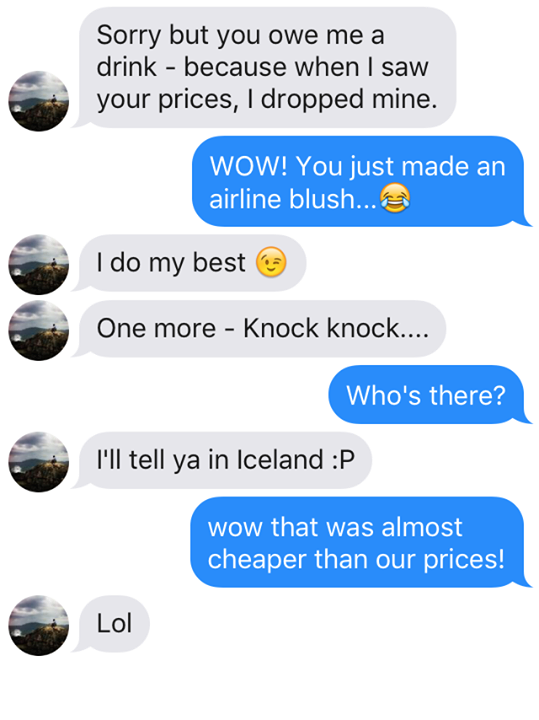It’s clear now that Snapchat is here to stay. But few marketers seem to have understood why, or what to do with it. In this article, we look at why this is happening and how airlines can take advantage of this new tool.
We will not start with the impressive statistics about usage that you can find almost everywhere. Instead, we have two words for you: intimacy and hype.
Intimacy
I know what you are thinking. Snapchat’s messages are deleted within a few seconds of being viewed so they are ideal for “intimate” messages. True, but not quite the direction to go in to understand the real value of the app, and the reasons for its popularity.
A more reasonable starting point is the definition of intimacy as a feeling of closeness, as something that allows people to share a moment. Moments cannot be re-lived — we cherish them because they are not repeatable and will only be known to those who were there to see them. Sharing these moments, without diluting their ephemeral nature, is exactly what Snapchat is good at. This is the key to both its value and its popularity.
For many of us this can be hard to understand. But for younger generations this sharing of moments has a magnetic appeal. This is not because they are young and reckless, but rather because they were brought up in a world where everything can be recorded, shared and seen later. A world where people meet in person less often, and where friends can be half a world away.
In this context, an un-recordable moment can be very appealing.
So what’s in it for the airline?
For airlines, the name of the game is simple: it’s called brand.
Brand building on a platform like Snapchat will, of course, differ from one company to the other. However, it should always be based on portraying a human image of the airline to build trust and to remain top of mind.
The best way to achieve this is do what a person would do — share bits of his/her daily life. This can be a picture from the flight deck, a video of the office, a snap from a new aircraft or a quick view of a destination or, well, the possibilities are endless.
What all good campaigns will have in common, however, is that they will be true to the airline’s brand. Moreover, they will show something normally hidden from sight — something “intimate” from the perspective of one of the humans embodying the airline and its brand.
Beyond the hype
As with most things that are new, confusing, and popular, Snapchat was no stranger to hype. This was especially true in 2011 when it launched. At the time, most airline marketers dismissed it as not relevant to their brands and — to a large extent — they were right. They may not, however, be right for much longer.
As we have seen earlier, Snapchat does not appeal to younger generations because they are young, but because of their digital native upbringing. This implies that, as they age, the platform will remain relevant to their behaviour — and they will move into what airline consider their target market.
The first signs are already here. In 2014, 60% of Snapchat users were between 18 and 24 years old, today only 45% are within that same range. Some airlines have noticed it and have joined Snapchat.
The short term benefits for these brands are mostly related to the PR generated by joining a new platform, enhanced by the “hype” that still surrounds it. The longer term gains, however, are far more interesting and connected to their ability to improve their brands — by leveraging intimacy and staying top of mind in a crucial market segment.
Our industry
Today, there are at least 4 airlines prominently on Snapchat: Aer Lingus, Wow Air, Virgin America and American Airlines. Of these, the first two were especially successful at leveraging the hype for PR purposes. Aer Lingus was the first airline on Snapchat, and Wow Air launched a spectacular campaign that combined Tinder (a popular dating app) and Snapchat.
Wow Air was also one of the first to have a clear business goal that went beyond PR. It used the Tinder/Snapchat combination to launch its new services linking Iceland to the USA. Users were invited to follow the airline on Snapchat in order to find out where it was using Tinder. Having discovered the city, they could then attempt to “seduce” the airline and win tickets to its new destinations.
With the campaign, the airline achieved a number of goals. First, it was able to get considerable PR for its route launch; second, it built awareness amongst a young audience that is ideal for its low cost flights; and third, it created a loyal following on Snapchat that it is now leveraging to build long term brand awareness.
The road ahead
As the platform increases in relevance for airlines, we are likely to see more of them joining and launching initiatives. When they join, however, they will face a rather steep learning curve unlike that seen on Facebook of Twitter.
This new curve is made steeper by both the intimacy of the platform — which calls for a more brand focused approach — and the ephemeral nature of the messages that makes it nearly impossible to analyse what other airlines have done in the past.
To overcome this challenge, we at SimpliFlying are already following all airlines currently on Snapchat, and monitoring their efforts. If you are an airline marketer we’d recommend you do the same.
As always, if you have any questions, write to us, and we’ll be happy to answer.



